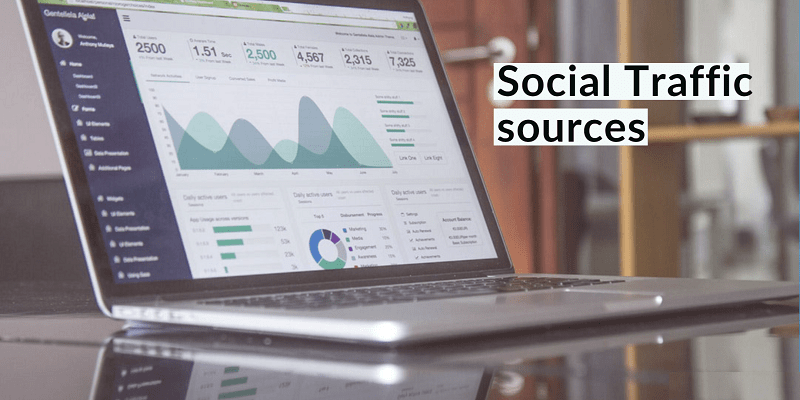
The social traffic to your site can come from different sources, and it is essential for you to know these sources. This will help you to get the required data from these various sources and analyze the quality and engagement of your site traffic.
You can use the free analytics software of Google to monitor the traffic of your traffic as well as the performance of your campaign. This tool is a very handy tool for businesses that do not have a proper marketing staff to get general as well as more detailed information about your site and its properties.
The best part of Google Analytics is that it will not only let you know the sources but will also provide you with a breakdown of the traffic sources.
The different types of Traffic Sources to Your Website.
- Organic: These are the visitors to your site through Google search or any other search engine.
- Paid: This traffic comes from AdWords and other SEM campaigns.
- Direct: These are the visitors who type in your URL or have it bookmarked.
- Referral: These are the people who click a link when they browse another site to visit your website.
- Social: These are the visitors coming from the links posted on different social media platforms.
- Other: These are the visitors coming from different customized URLs designed for campaign tracking.
With the segmented measurement of your incoming traffic, you will know the type of traction your social media marketing campaigns are receiving. You will also get snapshots of each of these sources, the volume of traffic over time, and the conversion rates of the followers for Instagram or any other social platform for the goals that you have set up.
The Social Traffic Sources To Your Website vary
Usually, the different categories of social traffic will vary widely between various sites. For example, some sites may have more than 90% of traffic coming direct, and on the other hand, for some sites, most of the traffic of a few other sites may come through search engine queries.
With such variance, it may be said that there is no accurate breakdown of the traffic. Therefore, it is essential to know your goals and keep them in your mind. This will help you a lot when you consider the areas wherein you will need to optimize.
It is also good to know for a better analysis that it is the external sources that will typically send the maximum number of new visitors and the most loyal audience of your business will, by all chances come as direct traffic to your homepage.
Quality of direct traffic
The direct traffic typically lands on the front pages or sections of the home pages. These are the pages that link to other content instead of providing content all by themselves. This means that when you look for engagement on the landing pages of different types of traffic, this type of traffic will not produce any useful data because the landing pages are not intended to provide any engagement.
- You will be better off if you ask how deeply these people read the content on arrival and
- How often do they come back to the site to know more?
When you look at things from these two perspectives, you will see that direct traffic outperforms the norm by far. You will see that:
- The direct traffic comes back to a site about 3 to 4 times a week and
- They view nearly nine articles in a week.
This data is drastically different in comparison to any other average visitor who is found to visit a site 1 to 2 times a week and view only 2 to 3 articles.
Therefore, to know the quality of direct traffic, you must know the ratio of the number of daily direct visitors and the number of weekly or monthly direct traffic to your site.
Looking at the demographics
Before you start evaluating your social traffic, it is vital to know a few other things as well. You must know the type of visitors coming to your site from social sites. You must also know how exactly they read.
The social sources are much better as compared to any average source of new traffic to your site. Research says that:
- 31% of the traffic to a website comes from new visitors and
- 41% of social visitors are new.
There is another good thing about social traffic. This traffic is dramatically and typically more mobile-based as compared to other types of site traffic. it is known through different studies that:
25% to 40% of the site traffic comes from mobile, depending on the performance of the site itself. Therefore, you must create better content and push your stories to social media which would affect the quality and number of traffic to your site. However, you must know the right time to push your stories on social media.
Using bounce rate
When you analyze your traffic sources, the best parameter that will help you in your job is the bounce rate. You should start by navigating the sub-menu of all traffic sources and collect the info on the bounce rate for a specific period.
Typically, the bounce rate is an excellent indicator of the engagement of a visitor on any eCommerce site. This will help you to know and measure:
- The percentage of traffic to your website that made a single-page visit and
- The percentage of visitors that landed on your site but left without clicking on the other pages.
When you compare these rates, you will come to know about the compatibility of the visitor with your site. This will help you to make changes in your site that are necessary as well as in your social media marketing campaigns.
Therefore, the knowledge of the different types of traffic to your site as well as their sources will help you to improve the performance of your site as well as your social media marketing efforts. It will set both in the desired direction: north!
You might also like our Blogging section which contains exclusive tutorials on how you can make your life simpler by using technology.




